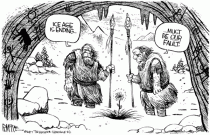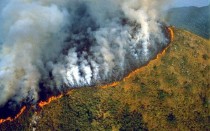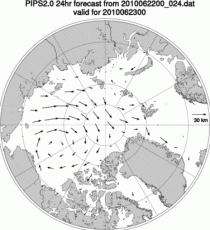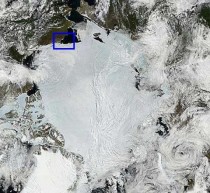Jun 28, 2010
New Study: CO2 only rose after ice age ended, not before; global wind-shift to blame
By Climate Change Fraud
A global shift in winds is what led to the end of Earth’s last ice age - an event that ushered in a warmer climate and the birth of human civilization.
It is believed that, in the geological blink of an eye, ice sheets in the northern hemisphere began to collapse and warming spread quickly to the south.

Enlarged here.
Most scientists say that the trigger, at least initially, was an orbital shift that caused more sunlight to fall across Earth’s northern half.
But they could not explain how the south dealt with the shift so fast.
And now a team of researchers looked for an answer towards a global shift in winds and proposed a chain of events that began with the melting of the large northern hemisphere ice sheets about 20,000 years ago.
The melting ice sheets reconfigured the planet’s wind belts, pushing warm air and seawater south, and pulling carbon dioxide from the deep ocean into the atmosphere, allowing the planet to heat even further.
Their hypothesis makes use of climate data preserved in cave formations, polar ice cores and deep-sea sediments to describe how Earth finally thawed out.
“This paper pulls together several recent studies to explain how warming triggered in the north moves to the south, ending an ice age,” said study co-author Bob Anderson, a geochemist at Columbia University’s Lamont-Doherty Earth Observatory.
“Finally, we have a clear picture of the global teleconnections in Earth’s climate system that are active across many time scales. These same linkages that brought the earth out of the last ice age are active today, and they will almost certainly play a role in future climate change as well,Ē he added.
“It’s the great global warming of all time. We’re trying to answer the puzzle: why does the Earth, when it appears so firmly in the grip of an ice age, start to warm?” said the study’s lead author, George Denton, a glaciologist at the University of Maine.
Scientists have long suspected that carbon dioxide played a major role in the last ice age but have had trouble explaining the early warming in the southern hemisphere, where glaciers in Patagonia and New Zealand were melting before carbon dioxide levels rose significantly.
Some scientists suggest that a change in ocean currents, triggered by the freshening of the North Atlantic, caused this early warming.
But computer models using ocean circulation to explain the rapid warming in the south have been unable to recreate the large temperature jumps seen in the paleoclimate record.
Now, with the evidence for shifting southern hemisphere westerlies, the rapid warming is readily explained.
The study has been published in the journal Science. See more here.
Jun 28, 2010
Amazongate: the missing evidence
By Christopher Booker
Last week the beleaguered global warming lobby was exulting over what it took to be the best news it has had in a long time. A serious allegation, which last January rocked the authority of the UN’s Intergovernmental Panel on Climate Change, was “corrected” as untrue by The Sunday Times, the newspaper which most prominently reported it. The reputation of the IPCC, it seemed, had been triumphantly vindicated. The growing tide of scepticism over climate change had at last been reversed. But this episode leaves many questions unanswered.
The “correction”, gleefully quoted by everyone from the WWF and The New York Times to The Guardian’s George Monbiot related to what was known as “Amazongate”. This was one of the series of controversies which exploded round the IPCC last winter, when it was shown that many of the high-profile claims made in its 2007 report had been based on material produced by environmental activists and campaigning groups rather than on proper, peer-reviewed scientific evidence.
2008 was the year man-made global warming was disprovedOne example, also reported in The Sunday Telegraph, was the IPCC’s much-publicised claim that climate change, leading to a reduction in rainfall, was threatening the survival of “up to 40 per cent” of the Amazon rainforest. The only source the IPCC could cite for this in its report was a document from the environmental advocacy group WWF. But last week The Sunday Times, in its prominent “correction” to its own story, conceded that the IPCCís claim was “supported by peer-reviewed scientific evidence” after all. Not identified, however, was the nature of this peer-reviewed evidence. Where is it?
The story of “Amazon-gate” has unfolded through three stages. Step one was the passage in the IPCC report almost identical to one made in a non-peer-reviewed WWF paper of 2000 on forest fires in the Amazon. Specifically the IPCC stated that “up to 40 per cent of the Amazonian forests could react drastically to only a slight reduction in precipitation”. But the only source the WWF in turn had been able to cite to support this was a paper published in Nature in 1999, from a team led by Dr Daniel Nepstad, formerly employed by the WWF but now the “senior scientist” with another advocacy group closely linked to the WWF, the Woods Hole Research Center. Certainly Nepstadís paper was peer-reviewed: however its subject was not climate change but the impact on the Amazon rainforest of “logging and fire”. It found that “logging companies in Amazonia kill or damage 10-40 per cent of the living biomass of forests”. This had nothing whatever to do with global warming but was cited as the origin of that “up to 40 per cent” figure later used by the WWF and the IPCC.

Step two, when all this was reported last January, was a disclaimer from the WWF, emphasising that its 2000 report did “not say that 40 per cent of the Amazon forest is at risk from climate change”. But it went on to say that the real source for its 2000 paper (which had been “mistakenly omitted") was another paper, “Fire in the Amazon”. This was also written by Dr Nepstad, as head of yet another advocacy group linked to Woods Hole, the Amazon Environmental Research Institute. Although it was now being suggested that this paper should have been cited as the original source for the IPCC’s claim, it too was not peer-reviewed. Thus, twice over, the IPCC’s claim appears to rest both on non-peer-reviewed science and on studies not related to global warming at all.
So great was the IPCC’s embarrassment over these revelations that the story moved to a third stage. Various scientists, led by Dr Nepstad, suggested further studies which might justify the claim. But an exhaustive trawl through all the scientific literature on this subject by my colleague Dr Richard North (who was responsible for uncovering “Amazongate” in the first place), has been unable to find a single study which confirms the specific claim made by the IPCC’s 2007 report. If one exists we would very much like to see it.
There are several studies based on computer models which attempt to estimate the possible impact of climate change on the Amazon rainforest, but none of these have so far supported that 40 per cent figure. Other researchers in turn have been highly critical of these models, suggesting that they are too crude to replicate the complex workings of the Amazonian climate system and that all observed evidence indicates that the forest is much more resilient to climate fluctuations than the alarmists would have us believe.
Nothing did more to excite attention over the effect of climate change on the rainforest than the exceptional drought of 2005, just when the IPCC’s 2007 report was being compiled. Since then, however, abnormally heavy rainfall in the region has brought disastrous floods to Brazil, both last year and again last week.
In other words there is a real mystery here. Nothing so far made public seems to justify an assertion that the IPCC’s specific claim is “supported by peer-reviewed scientific evidence”. In view of all the controversy this issue has aroused over several months, it might seem odd that, if such evidence exists, it hasn’t been produced before. Is it not now a matter of considerable public interest that we should be told what it is? See story here.
Another fine piece can be found here.
Research (below, enlarged here) shows the Amazon has benefited from increased CO2 even as deforestation took place (source CO2 Science).

Deforestation of the Amazon has been decreasing (below, enlarged here) .

Though the animal kingdom is being affected (below, enlarged here).

See also Amazongate, the Smoking Gun here.
Jun 27, 2010
BP, Greenpeace and the Big Oil Jackpot
By Jeff Blue (Dennis Quaid), Undercover Blues
In what passes for debate about climate change one of the most tiresome allegations is that skeptics are lavishly funded by big oil. As a result of this funding, so the argument goes, the public has been confused by those who’ll say anything in exchange for a paycheck.
“Follow the money” we’re told and you’ll discover that climate skeptics are irredeemably tainted. Ergo nothing they say can be trusted. Ergo their concerns, questions, and objections should be dismissed out of hand.
It’s therefore amusing that the current oil spill in the Gulf of Mexico is now drawing attention to the close relationship between climate change activists and BP - aka British Petroleum, an entity for which the descriptor “big oil” was surely invented.
According to the Washington Post the green group Nature Conservancy - which encourages ordinary citizens to personally pledge to fight climate change - “has accepted nearly $10 million in cash and land contributions from BP and affiliated corporations over the years.”
Gee, didn’t Greenpeace build an entire ExxonSecrets website to expose the allegedly diabolical fact that, over a 9-year-period (1998-2006) ExxonMobil donated a grand total of $2.2 million to a conservative think tank?
$10 million versus $2 million. Who do we suppose has the cozier relationship with big oil?
But that’s just the beginning. The Washington Post also points out that Conservation International, another green group which insists climate change represents a “profound threat,” has “accepted $2 million in donations from BP over the years and partnered with the company on a number of projects.”
Funny, Greenpeace doesn’t talk about that. Nor does it mention:
- that BP is funding research into “ways of tackling the world’s climate problem” at Princeton University to the tune of $2 million per year for 15 years
- that BP is funding an energy research institute involving two other US universities to the tune of $500 million - the aim of which is “to develop new sources of energy and reduce the impact of energy consumption on the environment”
- that ExxonMobil itself has donated $100 million to Stanford university so that researchers there can find “ways to meet growing energy needs without worsening global warming”
- The only dollar amounts Greenpeace cites in its explanation of why it decided to launch ExxonSecrets is that measly $2.2 million. Versus 10 + 2 + 30 + 500 + 100. Let’s see, which all adds up to...wait for it...$642 million.
If the world is divided into two factions - one that believes climate change is a serious problem and another that thinks human influence on the climate is so minimal it’s indistinguishable from background noise - one group has pulled off a bank heist while the other has been panhandling in front of the liquor store.
In the same document in which Greenpeace talks about the ExxonMobil money it chillingly asserts that climate “deniers” aren’t entitled to free speech. Why? Because “Freedom of speech does not apply to misinformation and propaganda.”
Actually, the big thinkers on the subject have consistently taken the opposite view. John Stuart Mill was adamant that no one has the right to decide what is or is not propaganda on everyone else’s behalf. He would have looked Greenpeace in the eye and told it to stop imagining that its own judgment is infallible.
More than a hundred years later Noam Chomsky famously declared that if you don’t believe in freedom of expression for opinions you despise you don’t believe in it at all.
If Greenpeace would like to have a serious conversation about who, exactly, is spreading misinformation I’m up for that - since it’s overwhelming obvious that the big oil jackpot was awarded to those on the Greenpeace side of the debate.
The fact that climate change activists have enjoyed such a powerful funding advantage and yet insisted all the while that the exact opposite was the case is troubling. It tells us a good deal about their intellectual rigour. About their character. And about their ability to distinguish fact from fiction.
If there really is a climate crisis, if our grandchildren’s future really is imperiled, these aren’t the people to lead us out of the wilderness.
Jeff Blue (Dennis Quaid), Undercover Blues
UPDATE (June 6): Reader Terry Kesteloot alerted me to the fact that the Greenpeace.org website is apparently infected with a “very low” risk computer virus. The links in this post to Greenpeace’s ExxonSecrets FAQ have therefore been replaced with links to a copy of the document that resides at Archive.org (scroll down once the page loads). If your machine has virus protection, the document may be viewed directly on the Greenpeace website.
ICECAP note: BP also granted $500,000 to the University of California Berkeley to study energy and the environment. That may be included in the above mention of grants to two universities. We should note BP donated nearly $1 million to the Obama Presidential campaign and was a finalist in a ‘safety award’ about to be given by the Obama administration to an oil company. Read about any of these in the old lamestream media?
Jun 26, 2010
Ice Dancing
By Steven Goddard, Guest Post on WUWT

In order to better visualize what is happening in the Arctic this summer, I generated an animation of satellite photos over the area of open water west of Barrow, AK. It reveals a very dynamic ice edge - with the ice moving as it is blown around by winds associated with the Beaufort Gyre.

The region of ice in the video is shown in blue below (enlarged here).

Here is what I see.
* The ice edge is moving left to right about 10 miles per day.
* Ice is being torn off the main ice sheet north of Barrow.
* A large chunk of ice in the center of the open water (on June 18) moves northwest, crashes into the main mass of ice, and disintegrates.
* Little evidence of melting.
* The landfast ice is not showing any changes.
* Lakes are still frozen solid.
What do you see? See post and comments here.
Jun 26, 2010
Climate Change Delayers Topple Rudd
Tom Arup
Julia Gillard has made no concrete commitment on when to put a price on carbon emissions, despite former Prime Minister Kevin Rudd urging his party to try passing an emissions trading scheme after the election.
Speaking after she had toppled Mr Rudd yesterday, Ms Gillard said she would now work to build a public consensus for a carbon price ‘’as vigorously as I can and as long as I need to.’’
‘’I will do this because I believe in climate change,’’ she said, ‘’I believe human beings contribute to climate change.’’
In April, the government delayed its emissions trading scheme until at least 2013, sparking a massive collapse in public support for Labor and Mr Rudd in opinion polls.
In his final statement as Prime Minister yesterday, Mr Rudd said he was proud of the fact the government tried three time to pass an emissions trading scheme, ‘’although we failed.’’
‘’And, if I had one point of future policy, it must be our ambition to pass a carbon pollution reduction scheme within this parliament, the one that follows, I mean, so that we can make a difference, a real difference, to climate change,’’ Mr Rudd said.
His comments are being interpreted as a parting shot at the ALP’s New South Wales right-wing faction, led by Senator Mark Arbib, who pushed for the government to dump the emissions trading scheme.
Senator Arbib and the NSW Right were also instrumental in bringing down Mr Rudd’s leadership.
A final decision to shelve the emissions trading scheme until 2013 was made in April by a cabinet subcommittee made up of Mr Rudd, Ms Gillard, Treasurer Wayne Swan and outgoing Finance Minister Lindsay Tanner.
Ms Gillard and Mr Swan - now Deputy Prime Minister - both actively campaigned within the government to defer the emissions trading scheme.
Ms Gillard said yesterday she did not want to ‘’in any way seek to diminish my role in making that decision’’.
‘’I came to that decision because I fundamentally believe that if you are going to restructure our economy so that we can deal with a carbon price and deal with all of the transformations in our economy that requires, then you need community consensus.’’
Story here. Another is here. See Andrew Bolt destroy the know nothing alarmist Flannery in this interview here.
|










